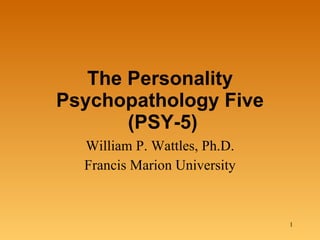Recommended
Big 5 model of personality & organizationally relevant personality traitsBig 5 model of personality & organizationally relevant personality traits

Big 5 model of personality & organizationally relevant personality traitsAl - Qurmoshi Institute of Business Management, Hyderabad
Recommended
Big 5 model of personality & organizationally relevant personality traitsBig 5 model of personality & organizationally relevant personality traits

Big 5 model of personality & organizationally relevant personality traitsAl - Qurmoshi Institute of Business Management, Hyderabad
More Related Content
What's hot
What's hot (20)
Challenges and opportunities of organisational behaviour

Challenges and opportunities of organisational behaviour
Viewers also liked
Viewers also liked (8)
How to use the Big 5 personality traits to write persuasive copy

How to use the Big 5 personality traits to write persuasive copy
Similar to The Big Five
Similar to The Big Five (20)
PSIKOLOGI KAUNSELING teori teori klasik dalam kaunseling - frued, jung adler

PSIKOLOGI KAUNSELING teori teori klasik dalam kaunseling - frued, jung adler
What Lies Beneath: Personality theories simplified

What Lies Beneath: Personality theories simplified
Introduction to psychology personality Intro to Psych Powerpoint personality

Introduction to psychology personality Intro to Psych Powerpoint personality
The Big Five
- 1. The Personality Psychopathology Five (PSY-5) William P. Wattles, Ph.D. Francis Marion University
- 46. The End
Editor's Notes
- conscientiousness agreeableness neuroticism openness extroversion-introversion
- In typical deductive test construction, the deduction leads to item writing; however, in replicated rational selection, deduction leads instead to item selection from a fixed item pool. In the replicated rational selection approach, lay item selectors are first trained to understand a psychological construct. Then the item selectors examine the defined pool of items, designating any items they feel tap the construct they have studied. However, unlike previous deductive systems in which the task is entrusted to one or two item writers or selectors, initial item selection is replicated across many selectors. Items that are repeatedly picked across the sample of selectors are used to form preliminary scales.
